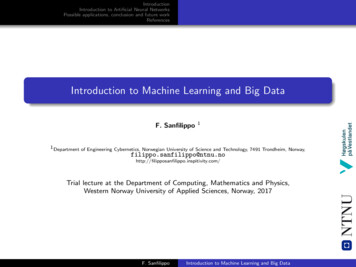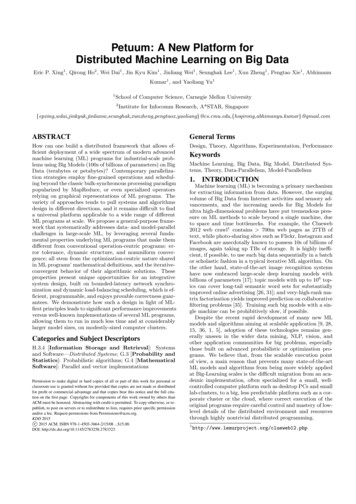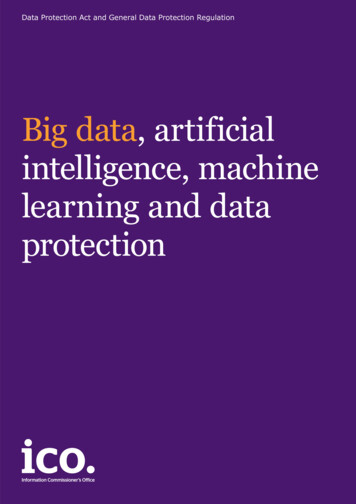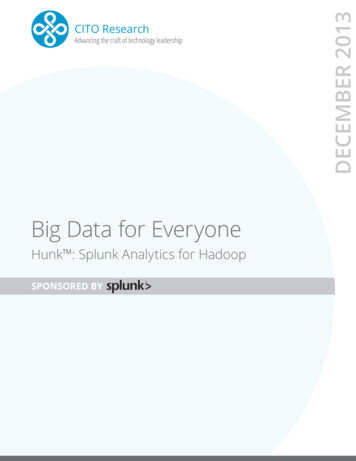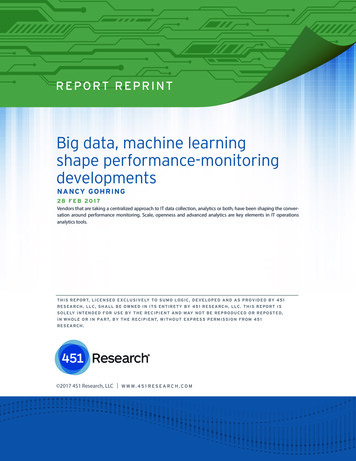
Transcription
R E P O RT R E P R I N TBig data, machine learningshape performance-monitoringdevelopmentsN A NCY GOHR ING28 F E B 20 1 7Vendors that are taking a centralized approach to IT data collection, analytics or both, have been shaping the conversation around performance monitoring. Scale, openness and advanced analytics are key elements in IT operationsanalytics tools.TH I S REP O R T, LI CENSED EX C LU SI V ELY T O SUM O L OGIC, DEVEL OPED AND AS PRO VIDED BY 451RE SE A R C H, LLC , SHALL BE O WNED IN IT S ENT IRET Y BY 451 RESEARCH, L L C. T HIS R EPORT ISSOL E LY I NTENDED FO R U SE BY THE R ECIPIENT AND MAY NOT BE REPRODUCED OR REPOST ED,IN W H O LE O R I N P AR T, BY THE R ECI P IENT, W IT HOUT EXPRESS PERMISSION FROM 451RE SE A R C H. 2017 451 Research, LLC W W W . 4 5 1 R E S E A R C H . C O M
451 RESEARCH REPRINTVendors that are taking a centralized approach to IT data collection, analytics or both have been shapingthe conversation around performance monitoring. We continue to see new entrants – including legacyvendors and startups – emerge with tools for collecting and analyzing the full stack of application andinfrastructure data. The ability to scale, a willingness to embrace openness across several fronts, and development of machine-learning techniques are key elements of the IT operations analytics (ITOA) toolsthat will define the performance-monitoring space.T H E 4 5 1 TA K ETo handle the growing volume of operations data that businesses collect, vendors are building big-data backends or advanced analytics tools that form, in essence, ITOA 2.0. The ability to scale, a willingness to embraceopenness across several fronts, and development of machine-learning techniques are key elements of thenew breed of tools that will define the performance-monitoring space. We expect competition in this space tointensify, with legacy vendors such as CA and BMC pursuing the opportunity, in addition to startups. Vendorswith point products, such as those that do application monitoring or server monitoring, will continue to havea role as collectors of specialized data that feed the big-data and analytics platforms. However, pressure onthese vendors to prove their value and differentiate will increase.CONTEXTWhere once applications were monolithic and comprised just a few services, modern applications are much more complex. They might include hundreds or thousands of microservices built on containers that spin up and down as needed,spanning on-premises servers, cloud workloads and even serverless deployments. Today’s apps might include code pushes that happen weekly, daily, hourly or even more frequently.Traditional performance-monitoring tools may not cut it when applied to these complex environments. One reason isthat those tools tend to be siloed, looking after networking, servers, application code, databases and cloud performanceseparately, without understanding the interconnections between those resources. Another is that they weren’t designedto handle the volume and variety of data issued from a modern application environment.We’ve seen a number of responses to this problem, including the platform approach, where individual vendors attemptto deliver a comprehensive set of data about the full stack. Another is the DIY approach, which typically stitches together some combination of open source and homegrown monitoring tools. IT operations analytics also responds tothis demand, although early versions fell short because they lacked sophisticated analytics and big-data capabilities.More recent tools for ITOA aim to allow users to collect data from almost any source – including directly from apps andinfrastructure, as well as from third-party monitoring tools – in order to run advanced analytics across this dataset thatrepresents much of the full stack.These are the key elements that we think are important to look for in these ITOA 2.0 offerings that define this space: Openness: Openness comes in several ‘flavors,’ such as the ability to ingest data from virtually any source, includingpotentially competitive third-party tools. This is key and overcomes one of the shortcomings of previous generationsof ITOA products that sometimes limit data ingestion and analysis to data collected by a single vendor. The reverse istrue, too – the vendors must make it easy for customers to ship data to another tool so that, for example, they can usethe analytics tool of their choice.Many, although not all, of the new tools rely on open source technologies, including Hadoop or pieces of the Elasticstack, on the back end. We think that strategic use of open source technologies will be key to enabling individualvendors to focus on differentiators and technology advances.
451 RESEARCH REPRINT Data agnostic: Some of these solutions are able to consume structured, semi-structured and unstructured data.Offerings that are able to combine and correlate logs, metrics, business data such as revenue, and social sentiment from sites like Twitter will deliver valuable insights to customers. Combining such disparate data sourcesisn’t easy. End users should consider the techniques vendors employ to normalize and analyze the data. Dothey convert logs to metrics and only retain the metric? Was the back end designed for metrics and, thus, onlysamples logs? The downsides to each approach may or may not impact utility for individual use cases. Scale and speed: Not every business will be collecting huge volumes of data, but large enterprises and webscale businesses will, and some of the offerings were designed with these customers in mind. Vendors servingthese segments discuss volume in terms of terabytes per day (and some, terabytes per hour) and search speedsin terms of seconds. Advanced analytics: Monitoring tools have long included predefined dashboards that visualize common analyses, such as error and traffic rates, over time. However, advanced analytics tools do more: they use machinelearning techniques to predict problems in advance; automatically build and adjust thresholds, issue alertswhen key performance indicators fall out of normal range; and correlate disparate data streams to developmeaningful alerts. They also typically allow users to perform sophisticated queries.We think that analytics capabilities will prove to be important differentiators. The vendors we talk to aren’t justusing tried-and-true machine-learning algorithms; instead, many are attempting to add techniques that injecttheir experience in operations monitoring to influence analytics outcomes. While we think that analytics will beimportant, some of the vendors we spoke with are concentrating on the back end, leaving open the possibilitythat customers will use their products primarily for data collection and normalization, relying on other tools foranalytics.VENDORSThis list isn’t comprehensive but includes vendors that we’ve recently heard position themselves as offering acentral IT operations data store or central IT operations analytics tool, or that we’ve seen being used by customersas such. We’ve seen some new entrants to this space, including from legacy vendors.BMCBMC’s TrueSight Intelligence collects and analyzes business and operations data from a variety of sources. Using aREST API, Intelligence can ingest data from third-party products such as Splunk and AppDynamics, BMC productslike TrueSight IT Data Analytics, and sources of business data such as a social sentiment app. BMC envisions a widearray of metrics and events that could be pulled into Intelligence beyond infrastructure performance metrics,including the number of tweets with a certain hashtag and alerts from IoT sensors. It built the system for scale,using open source tools, including Storm and Spark for real-time processing and streaming, as well as Cassandra.CAUsing a set of primarily open source technologies, CA has developed a modular big-data platform that it hopeswill power many of its products and potentially be productized for customers to use as they like. Known as ProjectJarvis, the engine follows a lambda data-processing architecture. It uses Elasticsearch as the service layer, HDFS,Spark and Spark streaming for data processing, and Kafka as the data bus.CA’s plan is to allow customers to use RESTful APIs to ingest data, such as logs, directly from the technology stack,as well as from many of CA’s products, such as App Experience Analytics, API Management and APM. Additionally,it expects to allow customers to ingest data from sources such as proprietary systems, and external sources suchas Twitter. The focus is on positioning Jarvis as a centralized IT data repository, with additional CA products offering an analytics layer.
451 RESEARCH REPRINTCI SCO/APPDY NAMICSAs part of its planned acquisition of AppDynamics, Cisco revealed that it’s been building an analytics softwareproduct that will ingest data from a variety Cisco and third-party sources, including Tetration, network monitoring,Cisco Umbrella and AppDynamics. It has not revealed much about the product yet but plans to unveil more withinthe next couple of quarters. We think that Cisco is in a strong position to deliver on this idea given its position innetworking, security and monitoring.DATADOGWith its long list of integrations for collecting metrics from infrastructure, and now applications, Datadog is beingused as a central IT operations analytics tool. It focuses on aggregating and correlating metrics from a wide varietyof resources and uses machine learning for anomaly detection.LOOMLoom is a new market entrant with a clear focus on analytics, running machine-learning technologies on data itcollects primarily from log tools (it ingests metrics as text) without retaining much of that data at all. The bulk ofLoom’s back end is proprietary, although it uses Elasticsearch for a search function and saves graphs in Graphite.While users can execute searches, Loom largely defers to popular log management vendors for the capabilitysince most of its customers already have a log management tool. In fact, Loom doesn’t store all the logs it ingests.Instead, it only saves the graphs for later reference, including a set of logs generated before and after an anomaly.ROCANARocana can ingest a large volume and variety of data – its largest customer collects roughly 1TB per hour – anddeliver advanced analytics that can be particularly useful when applied to a large and potentially historical set ofdata. Rocana’s technology is built on open source projects including Kafka, Impala, Avro and Parquet, with datastored in Hadoop Distributed File System.Rocana is trying to position itself as a centralized data repository that different teams – including site reliability,security and compliance, app developers, and business units – can access using its front end or the tools of theirchoice. The goal is to become the data warehouse for all machine data within an organization, from which different products can be deployed to access and analyze the data depending on the use case.Although it can’t name it publicly, Rocana has a large and recognizable retailer as a customer, which is using theproduct in this centralized manner, indicating that Rocana has successfully sold the concept in a large, complexenvironment. That type of case study is key for a young company such as Rocana that is tackling the challengingsale of a centralized data repository.SCALYRWhile it’s not there yet, Scalyr’s vision is to serve as a centralized repository for all operational data. Users couldpotentially tap into the data via third-party tools, or Scalyr might end up developing its own analytics and visualization front ends for monitoring application performance, for example.Even though Scalyr has work to do before it can achieve its vision, we think its technology shows promise thatmight be particularly useful to large deployments. Rather than use open source tools such as Elasticstack or Hadoop, Scalyr built a custom data store for its log management service to try to set itself apart from the pack. Itclaims that 95% of queries on the system return in under a second and that it searches at a lightning-fast 750GBper second. This homegrowm back end also supports large volumes of data, with one e-commerce customerregularly collecting 2TB per day and spiking to 10TB on the busiest day of the year.
451 RESEARCH REPRINTSUMO LOG I CSumo Logic argues that it has advantages over other vendors that combine metrics and logs because it was designed from the start to ingest time-series data, and it retains that data in its native format, where others – namelylog vendors that correlate metrics and logs – may convert time-series data to logs and retain just the logs. Compared to application performance management (APM) vendors that are now doing some log ingest, Sumo Logicis pushing the advantages of designing its systems to ingest varying types and volumes of data as it is produced,compared to APM tools, which tend to ingest at set increments. The result is that Sumo Logic can do real-time datastreaming, which it argues is useful in scenarios such as preventing a distributed denial-of-service attack, where acustomer was able to quickly learn about and shut down a suspicious server.Sumo Logic is also evolving its message to position itself not necessarily as a single tool that IT operations, DevOps, security and those in other roles use, but as a central data platform for all types of IT operations data thatcan be accessed by end users in various ways. An example of how that might work is its recent partnership withNew Relic, where customers can feed data from Sumo into New Relic Insights if they prefer New Relic’s analyticsand dashboarding capabilities. We think Sumo Logic is well positioned to establish itself as a central repository forIT operations and that it’s making the right partnerships to enable it.WAVEFRON TWavefront is a high-volume, low-latency platform for collecting, visualizing and analyzing metrics. It can ingestone million points per second and query at the same rate, putting it at the high end in terms of volume comparedwith other vendors. While about 70% of Wavefront customers instrument their code to generate custom metrics,customers also commonly pull in metrics from sources such as APM and NPM tools. A key use case that Wavefronttargets is tying in metrics from a variety of sources, including all layers of an infrastructure, to create a centralizedplace to do visualizations and analysis.Wavefront is working on adding machine-learning technology to boost its analytics capabilities, and it’s also developing better ways to incorporate logs. Both are key capabilities for its ability to compete as a centralized dataand analytics tool for IT operations.
BMC BMC's TrueSight Intelligence collects and analyzes business and operations data from a variety of sources. Using a REST API, Intelligence can ingest data from third-party products such as Splunk and AppDynamics, BMC products like TrueSight IT Data Analytics, and sources of business data such as a social sentiment app. BMC envisions a wide
